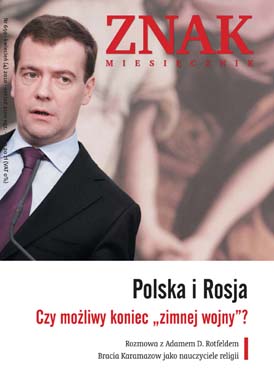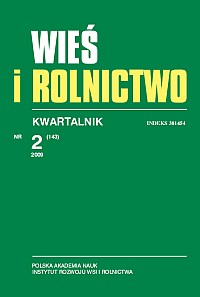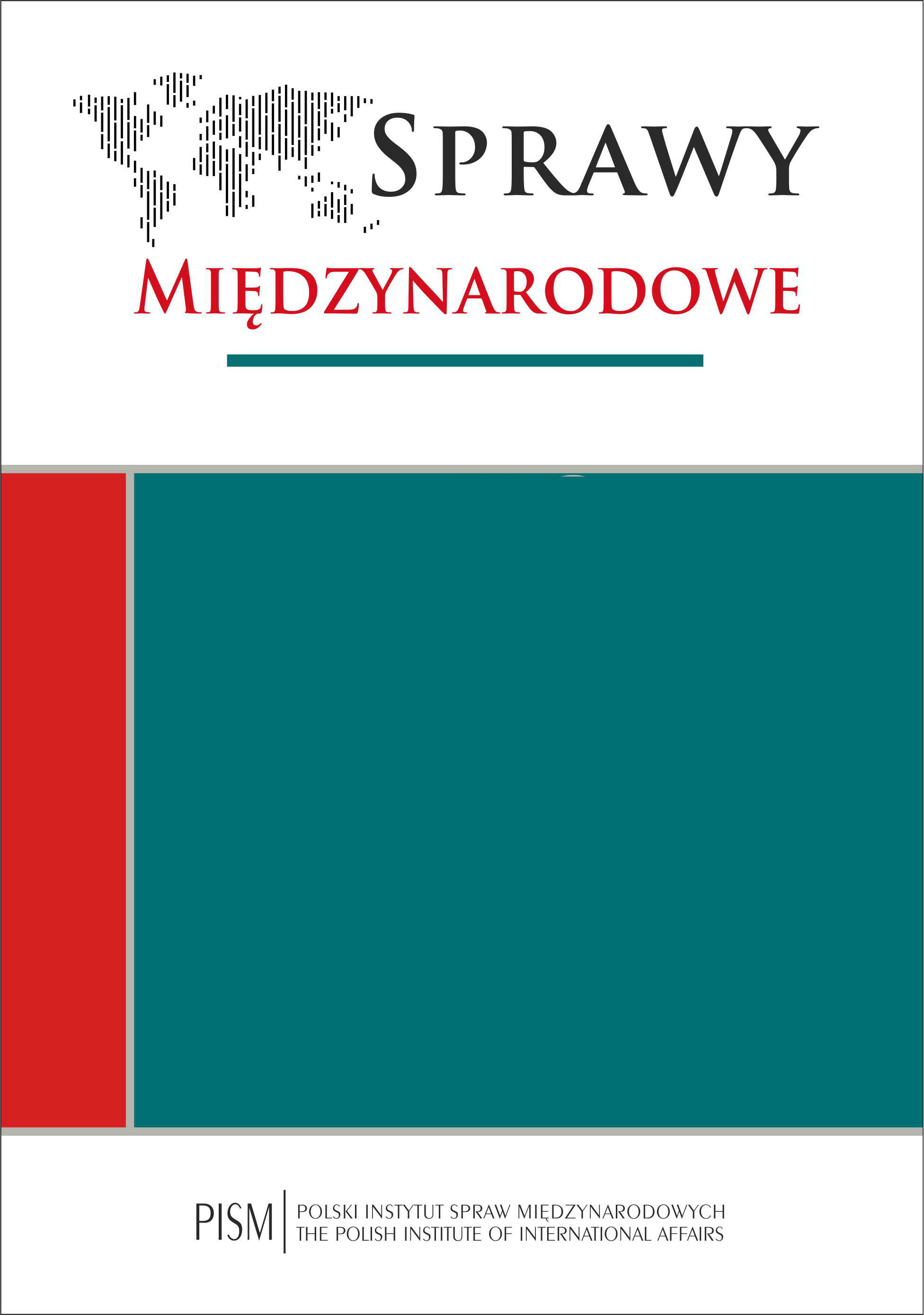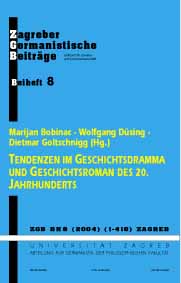
*** (April 2010)
*** (Kwiecień 2010)
Keywords: Bortnowska; ***; pomnik; memorial; pamięć; memory;
More...
Keywords: Bortnowska; ***; pomnik; memorial; pamięć; memory;
More...
Keywords: Głąb; Malewska; Stachewicz; review; recenzja; Ostryga i łaska
More...
Keywords: Chmielewska; Tischner; Ołowianka; Polska - kraj nadziei; Poland - Country of Hope; bezdomni; homeless
More...
Keywords: ancillary role; complaisance; servility; anti-rural paradigm; anti-peasant ideology; sociology's autonomy; służebność; usłużność; służalczość; paradygmat antyruralistyczny; antychłopska ideologia; autonomia socjologii
The article presents the possibility of taking a look at the history of Polish rural sociology through the prism of social roles played by that discipline in different years. During the period between the two world wars emphasis was being put on rural sociology's "ancillary" function defined by Władysław Grabski as a postulate of studying the rural community in order to adjust to its needs. During the period of communist rule in Poland rural sociology played at first a "servile" role, with sociologists conducting surveys to keep the rural population under surveillance and writing denunciatory reports that revealed the personal data of respondents at the time of intense Stalinist reprisals. Later on, the "complaisant" function became dominant, with the communist party using rural sociology to justify its ideological decisions (glorification of state-owned farms, analyses by peasants-workers, etc.). A permanent feature of Polish rural sociology has for years been excessively strict adherence to the model of rural community that fails to take into account the existence of many elements and the occurrence of many changes, and also the absence of a thorough theoretical reflection. In effect rural sociology lacks a paradigm of its own and sticks to the assumptions of general sociology which is anti-rural, and this results in the tendency to neglect the role of the rural community and agriculture. Artykuł prezentuje możliwość spojrzenia na dzieje polskiej socjologii wsi przez pryzmat ról społecznych, jakie pełniła ta dyscyplina w różnych okresach. W latach międzywojennych realizowana była funkcja „służebna”, sformułowana przez Władysława Grabskiego jako postulat poznawania wsi po to, by dostosowywać się do jej potrzeb. W okresie PRL-u mieliśmy najpierw do czynienia z funkcją „służalczą”, kiedy socjologowie prowadzili badania inwigilujące mieszkańców wsi oraz pisali raporty-donosy, odtajniając dane respondentów w czasie najgorszych represji stalinowskich. W latach późniejszych dominowała funkcja „usłużna”, gdy posługiwano się nauką dla uzasadnienia ideologicznych decyzji partii (gloryfikacja pgr-ów, analizy chłopo-robotników itp.). Stałą cechą polskiej socjologii wsi przez te wszystkie lata pozostaje zbyt sztywne trzymanie się modelu wsi, który nie uwzględnia istnienia wielu elementów ani dokonujących się przemian, a także brak pogłębionej refleksji teoretycznej. Owocuje to niewypracowaniem własnego paradygmatu, lecz trzymaniem się założeń antyruralistycznie zorientowanej socjologii ogólnej, a to sprzyja deprecjonowaniu wsi i rolnictwa.
More...
Keywords: EU membership; social change; social process; deruralisation; disagrarisation; re-stratification; social moods; ambivalent Europeanisation; członkostwo w UE; zmiana społeczna; proces społeczny; deruralizacja; dezagraryzacja; restratyfikacja
The article marks an attempt at the assessment of changes that have taken place in the rural areas of Poland over five years of its membership of the European Union. The changes attributable to Poland's presence in the European Union can be included in the series of changes that occurred in the country's rural areas in the late 1970s and the earl: 1980s as well as those brought about by systemic transformation launched in 1989. A loot at the Polish countryside from such perspective permits to see it as a dynamic space and to divide the occurring changes into three categories: the category of changes remaining within the scope of the earlier started processes, the category of changes correcting this processes and the category of changes inaugurating new process. The article consists of two parts In the first part the author describes the influence of EU membership on the long-term transformation processes started in the past: a slow-down in the pace of deruralisation of the countryside and dualisation of agriculture, a faster pace of disagrarisation and re-stratification of the rural community. In the article's second part the author deals with the spheres where new phenomena surface – chiefly, the sphere of social awareness (optimism, ambivalent Europeanisation) and the sphere of regulations that create the basis for a new civic character of the rural community. Artykuł jest próbą oceny zmian, jakie zaszły na wsi polskiej w ciągu pięcioletnie-go członkostwa w Unii Europejskiej. Zmiany, jakie niesie polskiej wsi przynależność do Unii Europejskiej, wpisują się w serię zmian, jakie dokonują się na polskiej wsi z przełomu lat 1970/1980 oraz zmian, będących efektem systemowej transformacji, zapoczątkowanej przez przełom 1989 roku. Patrząc z takiej perspektywy, wieś jawi się jako przestrzeń dynamiczna, a dokonujące się zmiany można podzielić na trzy rodzaje. Są to więc zmiany, które wpisują się w dotychczasowe procesy, zmiany, które dotychczasowe procesy korygują, oraz te, które nowe procesy zaczynają. Rozważania dzielą się na dwie części. W pierwszej ukazany jest wpływ członkostwa na długookresowe, już uprzednio istniejące procesy zmian: spowolnienie deruralizacji wsi i dualizacji rolnictwa, przyspieszenie dezagraryzacji oraz re-stratyfikacji wsi. W drugiej wskazane są obszary, na których pojawiają się zjawiska nowe, przede wszystkim w świadomości społecznej (optymizm, ambiwalentna europeizacja) oraz regulacje, tworzące bazę dla nowej obywatelskości wsi.
More...
Review of the book by Hranush Kharatyan: Live is very sad (powerty in Armenia). Hazarashen – Armenian Center for Ethnological Studies NGO, Yerevan, 2007
More...

Keywords: European Union; cohesion policy; structural funds; Cohesion Fund; member-states; effects of cohesion policy; Unia Europejska; polityka spójności; fundusze strukturalne; Fundusz Spójności; kraje członkowskie; efekty polityki spójności
The cohesion policy was adopted in 1988 with the purpose of reducing disproportions in the level of development of various regions of the Community's countries, and eliminating the backwardness of the underprivileged areas, rural areas included. In accordance with decisions taken at the time the cohesion policy was to be financed from structural funds, i. e. from the Orientation Section of FEOGA (the European Agricultural Guidance and Guarantee Fund), the European Regional Development Fund, the European Social Fund and — from 1993 — the Financial Instrument for Fisheries Guidance and, also, the Cohesion Fund. Since 1988 the cohesion policy has been modified several times (in 1994-1999, 2000—2006 and 2007—2013). In the 1988—2006 period the main beneficiaries of assistance available from the EU funds were the poorest member-states of the European Union — Spain, Greece, Portugal and Ireland. These countries allocated the obtained means to the development of infrastructure, human resources and production environment. The use of means obtained from the EU funds in 1988—2006 helped reduce the difference in the le-vel of development of the named countries and the remaining countries of EU-15. Polityka spójności ustanowiona została w 1988 roku. Celem jej było zmniejszenie dysproporcji w poziomie rozwoju regionów w krajach Wspólnoty oraz zmniejszenie zacofania najsilniej upośledzonych obszarów, w tym również obszarów wiejskich. Przyjęto wówczas, że polityka ta będzie finansowana z funduszy strukturalnych, tj. Sekcji Orientacji funduszu FEOGA, Europejskiego Funduszu Rozwoju Regionalnego, Europejskiego Funduszu Społecznego i od 1993 roku – Finansowego Instrumentu Wspierania Rybołówstwa, a także Funduszu Spójności. Od 1988 roku polityka ta była kilkakrotnie modyfikowana (w latach 1994–1999, 2000–2006 i 2007–2013). W latach 1988–2006 głównymi beneficjantami pomocy z funduszy unijnych były najbiedniejsze kraje członkowskie UE – Hiszpania, Grecja, Portugalia i Irlandia. Kraje te przeznaczyły uzyskane środki na rozwój infrastruktury, czynnika ludzkiego i otoczenia produkcyjnego. Wykorzystanie w latach 1988–2006 środków z funduszy unijnych przyczyniło się do ograniczenia dysproporcji w poziomie rozwoju pomiędzy wymienionymi krajami a pozostałymi krajami UE-15.
More...
Keywords: intervention in agriculture; agricultural policy instruments; agricultural policy) development trends in agriculture; interwencjonizm rolny; instrumenty polityki rolnej; polityka rolna; trendy rozwojowe rolnictwa
The paper describes development trends and directions of structural changes in the world agriculture as well as agriculture's role in the economies and societies of countries representing different levels of economic advancement. It analyses the traditional and contemporary premises of intervention in agriculture and the purposes and instruments o exerting influence on agriculture and development of rural areas. It also presents a genera model of intervention policy and modifications of that model introduced in different group of countries. The paper presents as well the essential features and determinants - attributable to interventionism, of agricultural policy systems. Praca przedstawia trendy rozwojowe i kierunki zmian strukturalnych w rolnictwie na świecie i jego rolę w gospodarce i społeczeństwie krajów o różnym poziomie rozwoju gospodarczego. Omawia tradycyjne i współczesne przesłanki interwencjonizmu rolnego oraz cele i instrumenty oddziaływania na rolnictwo i rozwój wsi. Prezentuje także ogólny model interwencjonizmu oraz jego modyfikowanie w różnych grupach krajów. Przedstawia również istotę i uwarunkowania, będące wyrazem interwencjonizmu systemów polityki rolnej.
More...
Keywords: structure of farms in accordance with economic quantity; acreage structure of agricultural farms; economic results of agricultural farms; barriers to an improvement in the structure of farms; lease of arable land; struktura gospodarstw
In Polish agriculture progress in the improvement of the structure of farms in accordance with economic quantity is insufficient in relation to the challenge of intensifying competition on the common agricultural market of the European Union and on the world agricultural market. In the conditions of globalisation and integration only modern and economically strong farms can ensure themselves a stable position in the emerging division of labour within EU 27. In the conditions prevailing in Poland the principal factor of improvement in the structure of farms in accordance with economic quantity is a radical change in the acreage structure of farms and mainly an increase in the proportion of farms having 30 ha and over 30 ha of arable land. However, progress in this respect, especially in recent years, has been very slow. The main barrier to faster progress is the lack of supply of arable land coming from farms liquidating or reducing their agricultural production. In this situation the popularisation and consolidation of the institution of lease ought to become an important factor of improvement in the agrarian structure of Polish agriculture. Therefore, the agricultural policy ought to facilitate the operation of farms using land under lease agreements and to strengthen the lessees' conviction about the lasting character of their work on the leased land. W rolnictwie polskim postęp w poprawie struktury gospodarstw rolnych według wielkości ekonomicznej jest nieadekwatny w stosunku do wyzwań w zakresie nasilającej się konkurencji na wspólnym rynku rolnym UE i na rynku światowym. W warunkach globalizacji i integracji tylko gospodarstwa nowoczesne, silne ekonomicznie mogą znaleźć swoje trwałe miejsce w podziale pracy, jaki kształtuje się w UE 27. W warunkach polskich podstawowym czynnikiem poprawy struktury gospodarstw według wielkości ekonomicznej jest zdecydowana poprawa struktury obszarowej gospodarstw, w tym przede wszystkim wzrost udziału gospodarstw o powierzchni 30 ha i więcej użytków rolnych. Jednak postęp w tym zakresie, szczególnie w ostatnich latach, jest bardzo wolny. Barierą jest tu brak podaży ziemi rolnej z gospodarstw rolnych likwidujących lub ograniczających produkcję rolną. Ważnym czynnikiem poprawy struktury agrarnej naszego rolnictwa powinno być upowszechnianie i umacnianie instytucji dzierżawy gruntów rolnych. Polityka rolna powinna zatem sprzyjać gospodarstwom opartym na dzierżawie i umacniać u dzierżawców poczucie trwałości gospodarowania.
More...
Keywords: food industry; environmental pollution; environmental protection expenditures; przemysł spożywczy; zanieczyszczenia środowiska; nakłady na ochronę środowiska
The article, on one hand, presents the food industry's impact on the natural environment and, on the other hand, describes the results of efforts to analyse the food industry's outlays on investments connected with environmental protection, basing on research conducted with the help of questionnaires. The research covered the food processing enterprises of the Lubelskie province. The surveyed enterprises, which are dispersed and characterised by a high degree of fragmentation, have a strong influence on the level of pollution in the region. This compels the food sector's entities to engage in environmental projects. In the analysed period the value of the sector's pro-ecological investments grew four times. These investments were most frequently financed from the food industry's own resources which accounted for more than a half of the expended amounts. Investments in waste-water management and investments in the protection of waters have the highest share in the structure of implemented pro-ecological ventures — both in terms of quantity and value. A division of the investments by type shows, however, that "end-of-pipe" investments, that is investments which limit the emission of the generated pollutants, are still dominating. W artykule przedstawiono, z jednej strony, poziom oddziaływania przemysłu spożywczego na środowisko naturalne, z drugiej zaś, na podstawie badań ankietowych podjęto próbę analizy nakładów inwestycyjnych poniesionych przez ten dział na ochronę środowiska. Ze względu na znaczenie w strukturze gospodarki zakresem przestrzennym badań objęto podmioty prowadzące działalność na terenie województwa lubelskiego. Przedsiębiorstwa przemysłu spożywczego, charakteryzujące się znacznym rozproszeniem i rozdrobnieniem prowadzonej działalności, mają istotny wpływ na poziom emitowanych zanieczyszczeń w regionie lubelskim. Fakt ten tłumaczy zaangażowanie podmiotów sektora spożywczego w działania na rzecz ochrony środowiska. W badanych latach odnotowano czterokrotny wzrost wartości zrealizowanych inwestycji proekologicznych. Najczęściej wykorzystywanym źródłem finansowania tych inwestycji są środki własne, stanowiące ponad połowę wydatkowanych środków. Największy udział w strukturze realizowanych przedsięwzięć proekologicznych, zarówno w ujęciu wartościowym, jak i ilościowym, stanowiły inwestycje w gospodarkę ściekową i ochronę wód. Uwzględniając podział inwestycji ze względu na ich rodzaj, należy stwierdzić, że wciąż dominują inwestycje „końca rury”, a więc ograniczające emisję już powstałych zanieczyszczeń.
More...
Keywords: rural areas; sustainable development; organic farming; obszary wiejskie; rozwój zrównoważony; rolnictwo ekologiczne
The supply of ecological products in the European Union is lower than the existing demand. Therefore, food produced with the help of organic methods is being imported from outside the Union. The growing support for pro-environmental activities in agriculture creates prospects for the development of ecological production in Poland. An instrument serving the implementation of the EU agricultural policy in this respect is the Agro-ecological Programme within which payments designed to support the development of organic farming have been introduced. W krajach Unii Europejskiej podaż produktów ekologicznych nie pokrywa zapotrzebowania, dlatego importuje się żywność ekologiczną spoza Unii. Rosnące wsparcie działań prośrodowiskowych w obszarze rolnictwa stwarza perspektywę rozwoju produkcji ekologicznej w Polsce. Instrumentem realizacji polityki rolnej UE w tym zakresie jest Program Rolnośrodowiskowy, w którego ramach wprowadzono płatności wspierające rozwój rolnictwa ekologicznego.
More...
Keywords: migrations; trans-nationality; migration traditions; village; migracje; transnarodowość; tradycje migracyjne; wieś
The article presents the results of an analysis of migration traditions of the population of the Radgoszcz commune at the start of the 20th century and in the period following Poland's accession to the European Union within the concept of trans-nationality. The analysis has been conducted by the article's author with the purpose of establishing whether trans-national migrations, which are characterised by a large number of departures and returns, are actually a new social phenomenon. The author has chosen as the field for his exploration the Radgoszcz commune which forms a part of the Dąbrowski district in the region of Małopolska. At present the Dąbrowski district is an area characterised by a high index of international mobility (chiefly in the direction of Austria and Germany). At the start of the 20th century this district constituted the migration centre of Galicia. It should be noted, however, that a high proportion of migrants tended to return to their local communities and to repeat many times the same migration strategies. One of the proofs of strong migration traditions is the existence of two Polish community clubs in the United States, which group migrants (or the descendants of migrants) from the Radgoszcz commune. Basing on the results of field research, which covered, among other things, the examination of archival materials and the evaluation of their content, as well as a questionnaire, the author has analysed the region's migration traditions and their influence on the present international mobility of the inhabitants of the Radgoszcz commune. W artykule przedstawiono wyniki analizy tradycji migracyjnych mieszkańców gminy Radgoszcz na początku XX wieku oraz po wejściu Polski do Unii Europejskiej w ramach koncepcji transnarodowości. W tekście spróbowano odpowiedzieć na pytanie, czy migracje transnarodowe, cechujące się między innymi dużą dynamiką wyjazdów i powrotów, to rzeczywiście nowe zjawisko społeczne? Polem eksploracyjnym jest tu małopolska gmina Radgoszcz, która należy do powiatu dąbrowskiego. Jest to obecnie obszar o wysokim wskaźniku mobilności międzynarodowej (szczególnie w kierunku Austrii i Niemiec). Jednakże już na początku XX powiat dąbrowski był centrum migracyjnym w Galicji. Niemniej należy zauważyć, że duża część migrantów powracała do swoich społeczności lokalnych, jak również wielokrotnie powtarzała strategie migracyjne. Pozostałością silnych tradycji migracyjnych są między innymi dwa kluby polonijne w USA, które stowarzyszają migrantów (lub ich potomków) z gminy Radgoszcz. Na podstawie badań terenowych, obejmujących między innymi badania archiwalne, analizę treści oraz ankietę audytoryjną, przeanalizowano tradycje migracyjne regionu i ich wpływ na współczesną mobilność zagraniczną mieszkańców gminy Radgoszcz.
More...






Behandelt werden neuere Textbeispiele aus der literarischen Rezeption Georg Büchners, und zwar von Golo Mann, Hans Magnus Enzensberger, Frank Hodjak und Jürg Amann.
More...